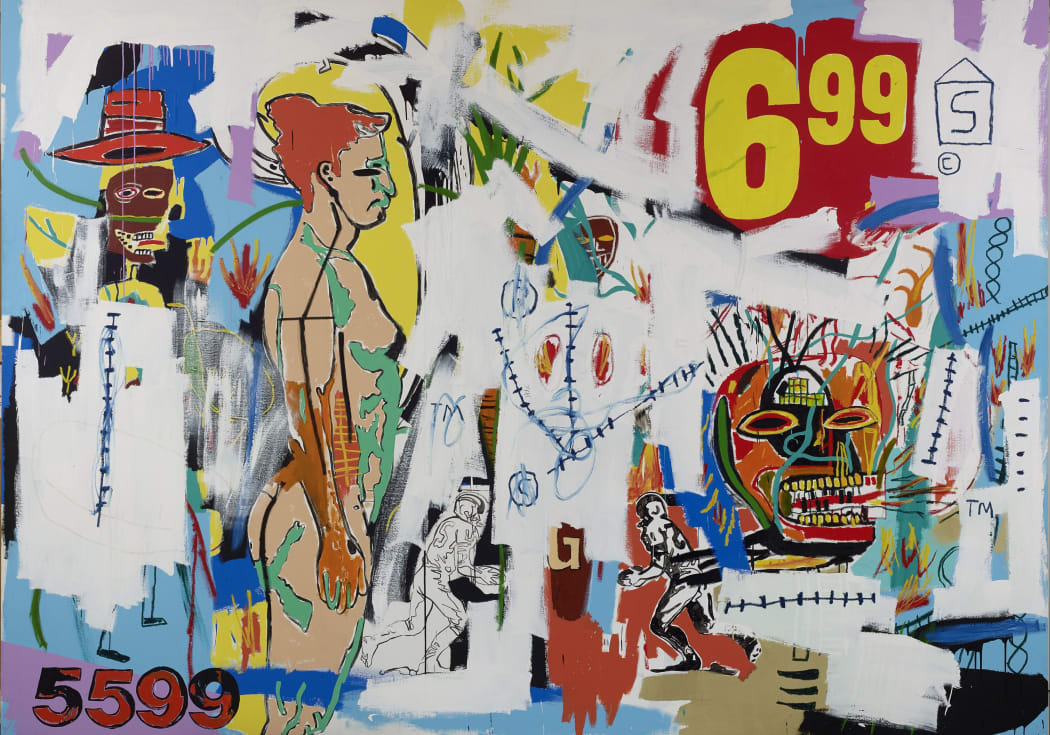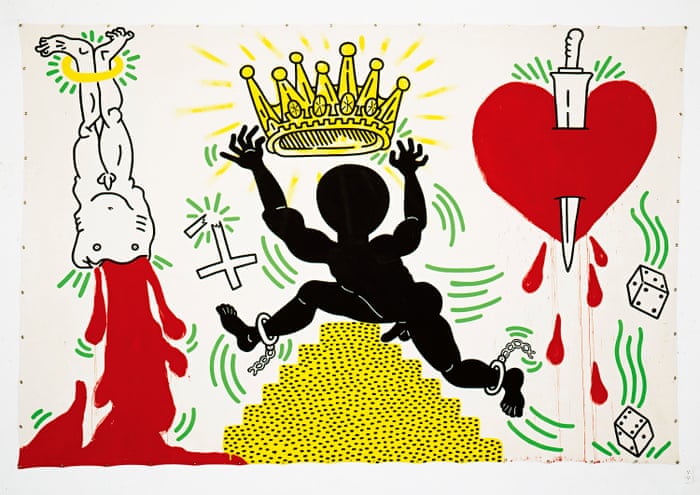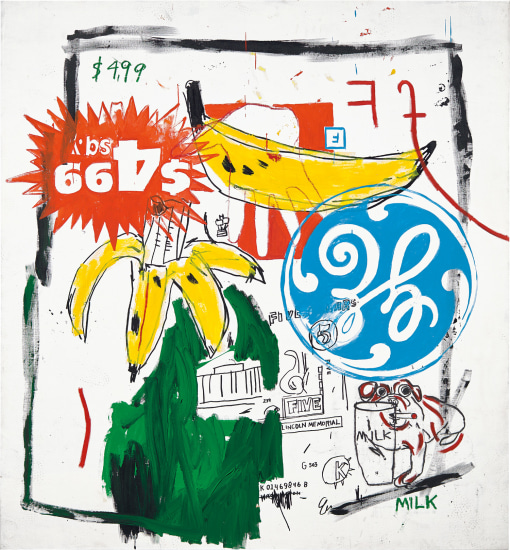
Andy Warhol and Keith Haring: The Mentorship
Andy Warhol, an iconic figure in the Pop art movement, took a keen interest in Keith Haring's work from the moment they met in 1983. Warhol recognized Haring's innate talent and became a mentor, guiding him through the complexities of the art world. The two shared a fascination with popular culture, and their relationship was mutually beneficial. Haring absorbed Warhol's wisdom about navigating the art market and media attention, while Warhol was invigorated by Haring's youthful energy and fresh approach to art.
Andy Warhol's influence on the art of Keith Haring was profound and multi-faceted. Their close personal and professional relationship in the 1980s New York art scene played a significant role in shaping Haring's artistic style and approach. Here are several ways in which Andy Warhol influenced Keith Haring's art:
Andy Warhol recognized Keith Haring's talent and became a mentor figure to him. Warhol's vast experience in the art world provided invaluable guidance to Haring as he navigated the complexities of the art market, gallery scene, and media attention.
Warhol's mentorship allowed Haring to gain insights into the business side of art, including strategies for promotion and handling fame. This mentorship helped Haring establish himself as a professional artist.
Both Warhol and Haring shared a fascination with popular culture and the impact of mass media on society. Warhol's Pop art had a profound influence on Haring's work, encouraging him to incorporate pop culture elements and everyday imagery into his art.
Haring, like Warhol, used recognizable symbols and iconography in his work, making his art accessible and relatable to a broad audience. This approach allowed Haring to convey his messages about social issues effectively.
Haring and Warhol engaged in artistic collaborations, producing joint works that showcased their distinct styles. These collaborations often merged Haring's kinetic line drawings with Warhol's iconic imagery. Working alongside Warhol exposed Haring to new techniques and ideas, expanding his creative horizons. The cross-pollination of their artistic sensibilities allowed Haring to experiment with different approaches and incorporate them into his repertoire.
Both artists were drawn to the idea of art existing beyond traditional gallery spaces. Warhol's "Factory" and Haring's chalk drawings in New York City's subway stations were examples of their interest in public art and the democratisation of creativity. Haring's use of public spaces for his artwork, influenced in part by Warhol's exploration of non-traditional art spaces, contributed to his reputation as a socially engaged artist who sought to reach a wide and diverse audience.
Keith Ha
Haring and Jean-Michel Basquiat: Collaborative Works
Haring's friendship with Jean-Michel Basquiat was not only personal but also creatively symbiotic. Their collaborations were a reflection of the urban environment and social issues that surrounded them. Haring's kinetic line drawings and Basquiat's raw, expressive text and imagery merged seamlessly in their collaborative works. Their shared exploration of themes such as race, identity, and inequality resonated strongly with the socio-political climate of the 1980s.
The personal and professional relationship between Keith Haring and Jean-Michel Basquiat was complex, filled with both camaraderie and competition. Their friendship emerged in the vibrant art scene of 1980s New York City, and their interactions had a significant impact on each other's lives and artistic trajectories. Here's an overview of their relationship:
Haring and Basquiat first met at a nightclub in 1980 and quickly became friends. They were drawn to each other's art and shared a common interest in graffiti, street art, and hip-hop culture. Both artists had gained recognition for their work in the streets of New York City before transitioning to gallery spaces.

Haring and Basquiat collaborated on several artworks during their friendship. These collaborative works often combined Haring's kinetic line drawings with Basquiat's raw and expressive text and imagery. Their artistic styles complemented each other, resulting in pieces that were visually striking and thematically rich. Their joint works explored themes such as race, identity, inequality, and the complexities of urban life. These collaborations allowed them to address social and political issues in a more profound and layered manner.
Beyond their artistic collaborations, Haring and Basquiat had a close friendship. They shared studio spaces, attended events together, and supported each other's careers. Basquiat, in particular, looked up to Haring as an older brother figure and often sought advice and guidance from him.
Despite their friendship, there were moments of tension and competition between Haring
and Basquiat. Both artists were rapidly rising stars in the art world, and the pressure of fame
and the market sometimes strained their relationship. Basquiat's meteoric rise to success, often accompanied by media hype, occasionally overshadowed Haring's work in the public eye. This dynamic led to moments of jealousy and insecurity, though it did not ultimately fracture their friendship.
Their artistic exchange was evident in their individual works. Haring, influenced by Basquiat's raw energy, experimented with text and more abstract imagery in some of his pieces. Basquiat, on the other hand, began to incorporate a more graphic and illustrative quality into his paintings, which he attributed to Haring's influence.
Andy Warhol and Jean-Michel Basquiat: A Complex Partnership
The relationship between Warhol and Basquiat was more complex, characterised by a blend of mentorship and competition. Basquiat initially idolised Warhol and saw him as a father figure, even inviting him to collaborate on joint works. However, the collaboration revealed tensions between their artistic sensibilities. Basquiat's raw and emotional style clashed with Warhol's detached and calculated approach.
Andy Warhol, born in 1928, was already a household name by the time he crossed paths with the young and emerging Jean-Michel Basquiat. Warhol was a pioneer of the Pop Art movement, celebrated for his iconic Campbell's soup cans, Marilyn Monroe portraits, and fascination with celebrity culture. By the time he met Basquiat in the early 1980s, Warhol was an established figure in the art world, enjoying both critical acclaim and commercial success.
In stark contrast, Jean-Michel Basquiat was a rising star, born in 1960, and emerging from the gritty streets of New York City's Lower East Side. Basquiat's work was marked by raw energy, vividly expressive imagery, and a deep engagement with themes of race, identity, and social injustice. His graffiti-inspired art had quickly gained recognition in the burgeoning downtown art scene, earning him a reputation as a young genius.
The meeting of these two artists was serendipitous. Warhol and Basquiat's paths crossed at a gallery in 1982, and their collaboration began with Basquiat creating graffiti-style drawings over Warhol's iconic imagery. This fusion of Warhol's Pop sensibilities and Basquiat's street art aesthetic gave birth to a series of collaborative works that would come to define their partnership.
Their collaborative pieces were a visual dialogue, a conversation between two distinct artistic voices. Basquiat's spontaneous, gestural style juxtaposed against Warhol's meticulous, screen-printed compositions created a powerful tension that captivated the art world. In these works, they explored themes of race, identity, and the commodification of art and artists themselves.
Beyond the art they created together, Warhol and Basquiat shared a personal connection that transcended their generational and cultural differences. Warhol, almost like a mentor, took Basquiat under his wing, introducing him to the upper echelons of the art world. Their friendship was marked by shared meals at famous New York restaurants, studio visits, and late-night conversations.

However, their partnership was not without its challenges. As Basquiat's star continued to rise, tensions arose over issues of authorship and credit for their collaborative works. Basquiat was keenly aware of the power dynamics at play in the art world and struggled with being seen as a protege of Warhol rather than an independent artist.
Tragically, Jean-Michel Basquiat's life was cut short when he passed away in 1988 at the young age of 27. Warhol himself would follow just a year later. Despite their brief but impactful collaboration and the challenges they faced, the legacy of their artistic partnership endures. Their works continue to be celebrated, exhibited, and auctioned at staggering prices.
Discover Keith Haring prints for sale, Andy Warhol signed prints and buy Jean-Michel Basquiat limited edition prints at Andipa Editions.